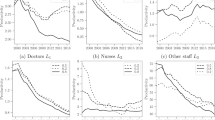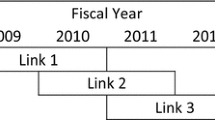Abstract
We analyze hospital efficiency and productivity growth using an innovative approach which employs the directional distance function and the Luenberger productivity indicator. The primary advantage of our approach is that both input contractions and output expansions are considered. Our model generates a productivity indicator that is decomposed into the usual constituents of productivity growth: technological change and efficiency change. For the sake of comparison, we also use the Malmquist productivity index. The empirical results based on a sample of Portuguese hospitals from 1997 to 2004 show that, on average, those hospitals experienced very weak productivity growth over that period. In addition, the incidence of technological change was remarkably low.

Similar content being viewed by others
References
Boussemart JP, Briec W, Kerstens K, Poutineau JC (2003) Luenberger and Malmquist productivity indices: theoretical comparisons and empirical illustrations. Bull Econ Res 55:391–405
Hollingsworth B, Street A (2006) The market for efficiency analysis of health care organizations. Health Econ 15:1055–1059
Carreira C (1999) Economias de escala e de gama nos hospitais públicos Portugueses: Uma aplicação da função de custo variável translog, GEMF Discussion Paper No. 1. University of Coimbra
Dismuke C, Sena V (1999) Has DRG payment influenced the technical efficiency and productivity of diagnostic technologies in Portuguese public hospitals? An empirical analysis using parametric and non-parametric methods. Health Care Manage Sci 2:107–116
Lima E (2000) A produção e a estrutura de custos dos hospitais públicos: Uma aplicação de um modelo translogaritmico. Associação Portuguesa da Economia da Saúde Discussion Paper No. 2
Ozcan Y, Luke R, Haksever C (1992) Ownership and organizational performance: a comparison of technical efficiencies across hospitals types. Med Care 30(9):781–784
Valdmanis V (1992) Sensitivity analysis for DEA models. J Public Econ 48:185–205
Burgess J, Wilson DW (1993) Technical efficiency in veterans administration hospitals. In: Fried H, Lovell C, Schmidt SS (eds) The measurement of productivity efficiency: techniques and applications. Oxford University Press, Oxford
Dalmau E, Puig-Junoy J (1998) Market structure and hospital efficiency: evaluating potential effects of deregulation in the National Health Service. Rev Ind Organ 13:447–466
Rodríguez-Álvarez A, Lovell C (2004) Excess capacity and expense preference behaviour in national health systems: an application to the Spanish public hospitals. Health Econ 13(2):157–169
Siciliani L (2006) Estimating technical efficiency in the hospital sector with panel data: a comparison of parametric and non-parametric techniques. Appl Health Economics Health Policy 5(2):99–116
Morey R, Fine D, Loree SW (1990) Comparing the allocative efficiency of hospitals. Int J Manag Sci 18(1):71–83
Byrnes V, Valdmanis V (1994) Analysing technical and allocative efficiency of hospitals. In: Charnes A, Cooper W, Lewin A, Seiford LM (eds) Data envelopment analysis: theory, methodology and applications. Kluwer, Dordrecht
Beguin C, Simar L (2004) Analysis of the expenses linked to hospital stays: how to detect outliers. Health Care Manage Sci 7(2):89–96
Ferrier G, Rosko M, Valdmanis V (2006) Analysis of uncompensated hospital care using a DEA model of output congestion. Health Care Manage Sci 9(2):187–188
Barbeta G, Turati G, Zago A, Behavioural differences between public and private non-profit hospitals in the Italian Health Service. Health Economics (forthcoming)
Pilyavsky A, Aaronson W, Bernet P, Rosko M, Valdmanis V, Golubchikov M (2006) East–west: does it make a difference to hospital efficiencies in Ukraine? Health Econ 15(11):1173–1186
Häkkinen U (2005) The impact of changes in Finland’s health care system. Health Econ 14(S1):S101–S118
Hofmarcher M, Paterson I, Riedel M (2002) Measuring hospital efficiency in Austria: A DEA approach. Health Care Manage Sci 5(1):7–14
Blank J, Eggink E (2004) The decomposition of cost efficiency: an empirical application of the shadow cost function model to Dutch general hospitals. Health Care Manage Sci 7(2):79–88
Greene W (2004) Distinguishing between heterogeneity and efficiency: stochastic frontier analysis of the World Health Organisation’s panel data on national health care systems. Health Econ 13:959–980
Rosko M (2001) Cost efficiency of US hospitals: a stochastic frontier approach. Health Econ 10(6):539–551
Zuckerman S, Hardley J, Jezzoni L (1994) Measuring hospital efficiency with a cost function. J Health Econ 13(3):255–280
Caves R, Porter M (1977) From entry barriers to mobility barriers: conjectural decisions and contrived deterrence to new competition. Q J Econ 91:241–261
Barney J (1991) Firm resources and sustained competitive advantage. J Manage 17:99–120
Rumelt R (1991) How much does industry matter? Strateg Manage J 12(3):167–185
Wernerfelt B (1984) A resource-based view of the firm. Strateg Manage J 5(2):171–180
Teece D, Pisano G, Shuen A (1997) Dynamic capabilities and strategic management. Strateg Manage J 18(7):509–533
Jensen M, Meckling W (1976) Theory of the firm: managerial behaviour, agency costs and capital structure. J Financ Econ 3:305–360
Liebenstein H (1966) Allocative efficiency vs. X-efficiency. Am Econ Rev 56(3):392–415
Luenberger D (1992) Benefit function and duality. J Math Econ 21:461–481
Dupuit C (1848) De la mesure de l’utilité des travaux publics. Ann Ponts Chaussées 8:332–375
Chambers R, Chung Y, Färe R (1996) Benefit and distance functions. J Econ Theory 70:407–419
Chambers R, Chung Y, Färe R (1998) Profit, directional distance functions, and Nerlovian efficiency. J Optim Theory Appl 98:351–364
Shephard R (1970) Theory of cost and production functions. Princeton University Press, Princeton NJ
Briec W (1997) A graph type extension of Farrell technical efficiency measure. Journal of Productivity Analysis 8:95–110
Debreu G (1951) The coefficient of resource utilization. Econometrica 19:273–292
Farrell M (1957) The measurement of productive efficiency. J R Stat Soc 120:253–281
Banker R, Maindiratta A (1988) Nonparametric analysis of technical and allocative efficiency in production. Econometrica 56:1315–1332
Varian H (1984) The nonparametric approach to production analysis. Econometrica 52:579–597
Chambers R (1996) A new look at exact input, output, and productivity measurement, Department of Agricultural and Resource Economics Working Paper 96-05, University of Maryland
Chambers R, Pope RD (1996) Aggregate productivity measures. Am J Agric Econ 78:1360–1365
Färe R, Grosskopf S, Lindgren B, Roos P (1989) Productivity developments in Swedish hospitals: a Malmquist output index approach. In: Charnes A, Cooper V, Lewin A, Seiford L (eds) Data envelopment analysis: theory, methodology and applications. Kluwer, Dordrecht
Caves DW, Christensen LR, Diewert WE (1982) The economic theory of index numbers and the measurement of inputs outputs and productivity. Econometrica 50:1393–1414
Briec W, Chambers R, Färe R, Peypoch N (2006) Parallel neutrality. Journal of Economics 88:285–305
Boussemart JP, Briec W, Peypoch N, Tavéra C (2006) a-Returns to scale in multi-output production technologies, Unpublished paper
Balk BM, Färe R, Grosskopf S, Margaritis D, Exact relations between Luenberger productivity indicators and Malmquist productivity indexes. Economic Theory, forthcoming
Grosskopf S (2003) Some remarks on productivity and its decompositions. Journal of Productivity Analysis 20:459–474
Author information
Authors and Affiliations
Corresponding author
Rights and permissions
About this article
Cite this article
Barros, C.P., Gomes de Menezes, A., Peypoch, N. et al. An analysis of hospital efficiency and productivity growth using the Luenberger indicator. Health Care Manage Sci 11, 373–381 (2008). https://doi.org/10.1007/s10729-007-9043-6
Received:
Accepted:
Published:
Issue Date:
DOI: https://doi.org/10.1007/s10729-007-9043-6




